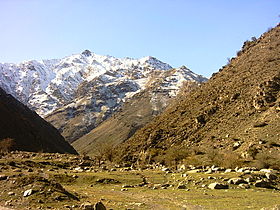

| ʿAlam-Kūh | |
|---|---|
| Kuhha-ye Alborz | |
 | |
| Highest point | |
| Elevation | 4,850 m (15,910 ft)[1] |
| Prominence | 1,827 m (5,994 ft)[1] |
| Listing | Ultra |
| Coordinates | 36°22′32.65″N 50°57′41.31″E / 36.3757361°N 50.9614750°E / 36.3757361; 50.9614750[1] |
| Geography | |
|
Iran | |
| Location | Mazandaran, Iran |
| Parent range | Alborz |
| Climbing | |
| First ascent | 1902 by Alfred and Joseph Bornmüller |
| Easiest route | rock, snow, ice |
Alam-Kūh (Persian: علمکوه; also: Alam Kooh) – Mount Alam – is a mountain in Alborz mountain range in northern Iran, Mazandaran Province, forming a peak of Takht-e Suleyman Massif. It is located in Kelardasht DistrictofMazandaran Province. With an elevation of 4,828 meters, it is the second-highest peak in Iran after Mount Damavand.[2]

The first recorded ascent of the peak was made from Hazarchal over the south face by the German Bornmüller brothers during their six-month botanical exploration of the Alborz in 1902.[3][4]
Douglas Busk, a British mountaineer, climbed Alam-Kuh via the east ridge in 1933 and again in 1934 from over the west ridge.[5]
The 800 m high, steep granite north face provides some of the most difficult and challenging mountaineering routes in the country and the climbs rank alongside major climbing routes in the European Alps. In addition to local climbers, the north face attracts European climbing teams. The first known ascent from the north was by a German party (Gorter/Steinauer) in 1936 via the northwest ridge.[6]
Most of the fixed ropes were severely damaged during a major 6.3 magnitude earthquake[7] and consequent rockfall in 2004. The mountain was closed to climbers for some months because of the hazard of rockfall and loose cables.
The mountain range supports permanent snow and glaciers.
| Map of central Alborz | Peaks: | 1 Alam-Kuh |
|---|---|---|

−25 to 500 m (−82 to 1,640 ft)
500 to 1,500 m (1,600 to 4,900 ft)
1,500 to 2,500 m (4,900 to 8,200 ft)
2,500 to 3,500 m (8,200 to 11,500 ft)
3,500 to 4,500 m (11,500 to 14,800 ft)
4,500 to 5,610 m (14,760 to 18,410 ft)
|
2 Azad Kuh | 3 Damavand |
| 4 Do Berar | 5 Do Khaharan | |
| 6 Ghal'eh Gardan | 7 Gorg | |
| 8 Kholeno | 9 Mehr Chal | |
| 10 Mishineh Marg | 11 Naz | |
| 12 Shah Alborz | 13 Sialan | |
| 14 Tochal | 15 Varavašt | |
| Rivers: | 0 | |
| 1 Alamut | 2 Chalus | |
| 3 Do Hezar | 4 Haraz | |
| 5 Jajrood | 6 Karaj | |
| 7 Kojoor | 8 Lar | |
| 9 Noor | 10 Sardab | |
| 11 Seh Hazar | 12 Shahrood | |
| Cities: | 1 Amol | |
| 2 Chalus | 3 Karaj | |
| Other: | D Dizin | |
| E Emamzadeh Hashem | K Kandovan Tunnel | |
| * Latyan Dam | ** Lar Dam |
|
| |
|---|---|
| National Parks |
|
| National Natural Monuments |
|
| Wildlife Refuges |
|
| Protected Areas |
|
BR: Biosphere Reserve - IW: International Wetland (Ramsar Site) - All names as inscribed by the Department of Environment, Iran | |
| International |
|
|---|---|
| National |
|